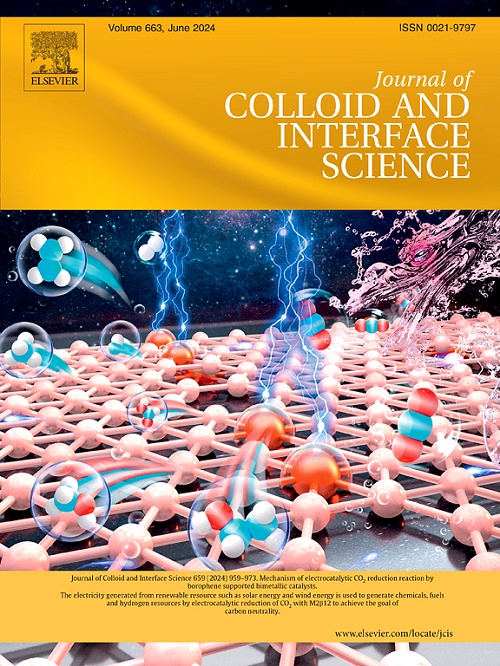电催化5-羟甲基糠醛氧化中共轭镍有机骨架原位转化为活性氢氧化镍的研究
IF 9.4
1区 化学
Q1 CHEMISTRY, PHYSICAL
引用次数: 0
摘要
利用电能有针对性地将生物质转化为有价值的分子是未来循环经济的重要组成部分。本文采用固态法合成了一种具有水杨酸醛键(1,3,5 -三甲酰间苯三酚:Tp)的镍基共轭金属有机骨架(MOF)。得到的二维框架(Ni-Tp)显示了5-羟甲基糠醛(HMF)到2,5 -呋喃二羧酸(FDCA)的高选择性电催化转化,具有优异的法拉第效率(96±4%)。原位拉曼光谱和x射线吸收光谱(XAS)表明,在电催化有机氧化反应(OOR)过程中,Ni-Tp作为均匀分散的氢氧化镍(NiOOH)的预催化剂。Ni-Tp的高效电子传递和新形成的镍(氧)氢氧化物的均匀分散以及优异的电解质可用性相结合,导致所有原位形成的镍位点具有氧化还原(和潜在的催化)活性。因此,就镍(氧)氢氧化物活性位点暴露而言,Ni-Tp是一种理想的预催化剂。这项工作证明了一种经济有效的方法来合成高效的mof基电催化剂用于相关的催化反应。本文章由计算机程序翻译,如有差异,请以英文原文为准。

In-situ transformation of a conjugated nickel-organic framework into active nickel oxyhydroxide for electrocatalytic 5-hydroxymethylfurfural oxidation
Utilizing electrical energy for the targeted conversion of biomass into valuable molecules is a crucial building block for a future circular economy. Herein, a Nickel (Ni)-based conjugated metal–organic framework (MOF) having salicylaldehydate linkages (1, 3, 5-triformylphloroglucinol: Tp) was synthesized via a solid-state process. The resulting 2D framework (Ni-Tp) demonstrates a highly selective electrocatalytic conversion of 5-hydroxymethylfural (HMF) to 2, 5-furandicarboxylic acid (FDCA) with excellent faradaic efficiency (96 ± 4 %). In-situ Raman and X-ray absorption spectroscopy (XAS) reveal that Ni-Tp acts as a precatalyst for uniformly dispersed nickel (oxy)hydroxide (NiOOH) in the electrocatalytic organic oxidation reaction (OOR) process. The combination of efficient electron transport of the Ni-Tp and the uniform dispersion of newly formed nickel (oxy)hydroxide with excellent electrolyte availability leads to redox (and potentially catalytic) activity of all in situ formed nickel sites. Thus, the Ni-Tp is an ideal precatalyst in terms of nickel (oxy)hydroxide active site exposure. This work demonstrates a cost-effective method for synthesizing efficient MOF-based electrocatalysts for a relevant catalytic reaction.
求助全文
通过发布文献求助,成功后即可免费获取论文全文。
去求助
来源期刊
CiteScore
16.10
自引率
7.10%
发文量
2568
审稿时长
2 months
期刊介绍:
The Journal of Colloid and Interface Science publishes original research findings on the fundamental principles of colloid and interface science, as well as innovative applications in various fields. The criteria for publication include impact, quality, novelty, and originality.
Emphasis:
The journal emphasizes fundamental scientific innovation within the following categories:
A.Colloidal Materials and Nanomaterials
B.Soft Colloidal and Self-Assembly Systems
C.Adsorption, Catalysis, and Electrochemistry
D.Interfacial Processes, Capillarity, and Wetting
E.Biomaterials and Nanomedicine
F.Energy Conversion and Storage, and Environmental Technologies

 求助内容:
求助内容: 应助结果提醒方式:
应助结果提醒方式:


